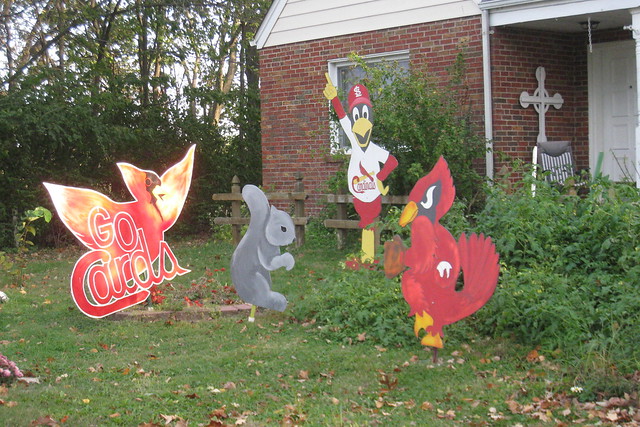I knew that all St. Louisans were bird watchers--specifically, Redbird watchers, but who knew they were squirrel watchers too? The yard art pictured above was created by one of my neighbors. It features "The Rally Squirrel" warming up before the big game. For those of you who are not from 'round here, or for those Americans who live under a rock, I have embedded video of the Rally Squirrel's moment of fame (posted by Andrewbeginning, Oct. 6, 2011).
Moaning about the economy has been replaced with chatter about the Rally Squirrel in my hometown. Of course, I had to have a St. Louis Cardinal's Rally Squirrel t-shirt. I found one at the grocery store. I've gotten so many compliments on it, I'm going to buy all my clothes at there from now on. It's so convenient--right next to the produce section.
Some years ago, I attended a lecture at the Missouri Botanical Garden, presented by Roger Swain. Swain was the science editor at Horticulture magazine, author of books about gardening, as well as a very entertaining host of the public broadcasting show, The Victory Garden, for 15 or so years. Swain discussed growing fruit in the home garden as well as nuts. That prompted a question from the audience about squirrels. Really, until recent sporting events, I thought everyone, particularly gardeners and bird watchers, hated squirrels. Swain answered with a story about a neighbor who--how can I put this politely--culled squirrels to protect her backyard nut crop. Another hand popped up immediately. "I'm an animal control officer in St. Louis, and I have successfully prosecuted a man who shot the squirrels in his yard for animal cruelty." Roger regarded the man through his spectacles for a beat, then announced, "If anyone in this audience is arrested for killing a squirrel, I will go your bail!" The audience exploded in laughter. (If you'd like to verify this anecdote, it's repeated in Bill Adler, jr.'s Outwitting Squirrels: 101 Cunning Stratagems to Reduce Dramatically the Egregious Misappropriation of Seed from Your Birdfeeder by Squirrels, 1996.)
The squirrel in the video was reportedly trapped, along with his buddies, at the stadium, then released in Castlewood State Park. A man who spotted my t-shirt told me that they trapped all the squirrels, but then let one go in the stadium again--just for luck. This is the kind of urban legend I love.
Perhaps it's a good thing they choose a large area like Castlewood's 1818 acres. Yesterday while walking the dog at a nearby college campus, I spotted a Red-tailed Hawk, sitting on the ground. As I approached, he took off, and I could just see a bushy, gray tail dragging behind. It seems from the Cardinal's performance against the Brewers (as I post this), the Rally Squirrel was spared once again.
.




